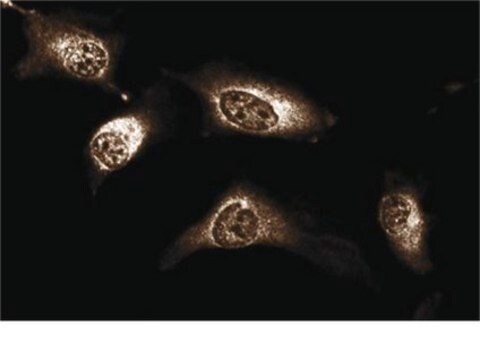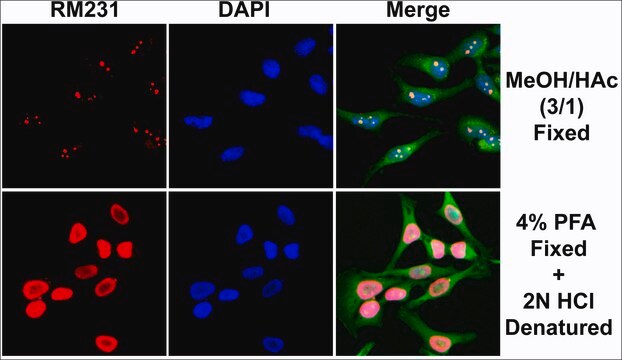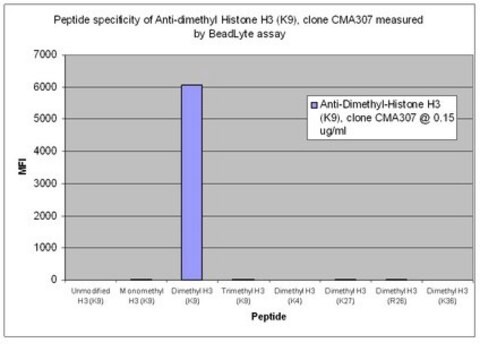05-1338
Anti-Dimethyl Histone H3 (Lys4) Antibody, clone CMA303
clone CMA303, from mouse
Sinonimo/i:
H3K4me2, Histone H3 (di methyl K4), H3 histone family, member T, histone 3, H3, histone cluster 3, H3
About This Item
Prodotti consigliati
Origine biologica
mouse
Livello qualitativo
Forma dell’anticorpo
purified immunoglobulin
Tipo di anticorpo
primary antibodies
Clone
CMA303, monoclonal
Reattività contro le specie
human, vertebrates
tecniche
ChIP: suitable
ELISA: suitable
dot blot: suitable
immunocytochemistry: suitable
immunoprecipitation (IP): suitable
multiplexing: suitable
western blot: suitable
Isotipo
IgG1κ
N° accesso NCBI
N° accesso UniProt
Condizioni di spedizione
wet ice
modifica post-traduzionali bersaglio
dimethylation (Lys4)
Informazioni sul gene
human ... H3C1(8350)
Descrizione generale
Specificità
Immunogeno
Applicazioni
Sonicated chromatin prepared from HeLa cells (1 X 106 cell equivalents per IP) were subjected to chromatin immunoprecipitation using 2 µg of either a normal mouse IgG, or Anti-dimethyl-Histone H3 (Lys4) antibody and the Magna ChIP G (Cat. # 17-611) Kit. Successful immunoprecipitation of dimethyl-histone H3 (Lys4) associated DNA fragments was verified by qPCR using ChIP Primers GAPDH Coding.
Please refer to the EZ-Magna G ChIP (Cat. # 17-409) or EZ-ChIP (Cat. # 17-371) protocol for experimental details.
Dot Blot Analysis:
Absurance Histone H3 Antibody Specificity Array (Cat. No. 16-667) and Absurance Histone H2A, H2B, H4 Antibody Specificity Array (Cat. No. 16-665), which contain histone peptides with various modifications were probed with Cat. No 05-1338, Anti-dimethyl H3 (Lys4), clone CMA303 at 2.0 µg/mL (1:500 dilution). Proteins were visualized using a Donkey anti-mouse IgG conjugated to HRP and a chemiluminescence detection system.
ChIP-seq Analysis:
Chromatin immunoprecipitation was performed using the Magna ChIP HiSens kit (cat# 17-10460), 2 µg of Anti-dimethyl-Histone H3 (Lys4) antibody (cat# 05-1338), 20 µL Protein A/G beads, and 1e6 crosslinked HeLa cell chromatin followed by DNA purification using magnetic beads. Libraries were prepared from Input and ChIP DNA samples using standard protocols with Illumina barcoded adapters, and analyzed on Illumina HiSeq instrument. An excess of sixteen million reads from FastQ files were mapped using Bowtie (http://bowtie-bio.sourceforge.net/manual.shtml) following TagDust (http://genome.gsc.riken.jp/osc/english/dataresource/) tag removal. Peaks were identified using MACS (http://luelab.dfci.harvard.edu/MACS/), with peaks and reads visualized as a custom track in UCSC Genome Browser (http://genome.ucsc.edu) from BigWig and BED files. The highest 25% of peaks identified in the 04-790 and 05-1338 datasets showed 92 and 90% overlap with peaks identified in the ENCODE H3K4me2 BROAD Histone track for HeLa S3.
Immunocytochemistry:
This antibody has been shown by an outside laboratory to be suitable for immunocytochemistry.
Immunoprecipitation:
This antibody has been shown by an outside laboratory to be suitable for immunoprecipitation.
ELISA:
This antibody has been shown by an outside laboratory to be suitable for ELISA
Multiplexing:
This antibody specifically recognizes histone H3 dimethylated on Lys4 by Luminex assay.
Epigenetics & Nuclear Function
Histones
Qualità
Western Blot Analysis: 2 μg/mL (1:500) dilution of this antibody detected dimethyl Histone H3 (Lys4) on 10 μg of HeLa acid extract.
Descrizione del bersaglio
Stato fisico
Stoccaggio e stabilità
Risultati analitici
HeLa Acid extract lysate
Altre note
Esclusione di responsabilità
Non trovi il prodotto giusto?
Prova il nostro Motore di ricerca dei prodotti.
Codice della classe di stoccaggio
12 - Non Combustible Liquids
Classe di pericolosità dell'acqua (WGK)
WGK 2
Punto d’infiammabilità (°F)
Not applicable
Punto d’infiammabilità (°C)
Not applicable
Certificati d'analisi (COA)
Cerca il Certificati d'analisi (COA) digitando il numero di lotto/batch corrispondente. I numeri di lotto o di batch sono stampati sull'etichetta dei prodotti dopo la parola ‘Lotto’ o ‘Batch’.
Possiedi già questo prodotto?
I documenti relativi ai prodotti acquistati recentemente sono disponibili nell’Archivio dei documenti.
Il team dei nostri ricercatori vanta grande esperienza in tutte le aree della ricerca quali Life Science, scienza dei materiali, sintesi chimica, cromatografia, discipline analitiche, ecc..
Contatta l'Assistenza Tecnica.







